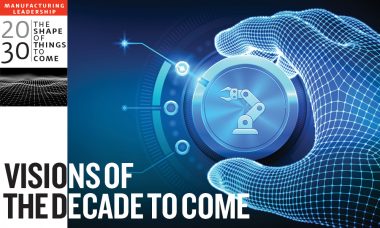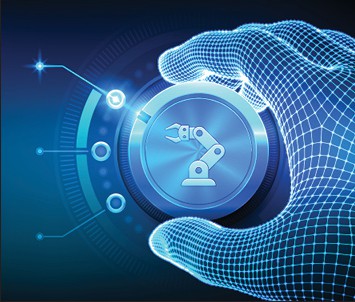
Customized, autonomous, micro-networked, localized, AI-rich, modular, and more sustainable? What will global manufacturing look like in the decade to come? Members of the MLC’s Board of Governors share their unique perspectives on the future of manufacturing in 2030. By Paul Tate

Detlef Zühlke
Executive Director of Europe’s SmartFactory EU network

Dr. Dean Bartles
President and Chief Executive Officer of the U.S.-based Manufacturing Technology Deployment Group

Michele D’Alessandro
Vice President and CIO of Manufacturing IT at Merck

Brad Heath
Chief Executive Officer and Owner of VirTex Enterprises.

Moderator
Paul Tate
MLC’s Co-founding Senior Content Director and Executive Editor
Over the last ten years the manufacturing industry has seen massive changes. Some aspects are almost unrecognizable today – from the way products are designed, to the technologies used to produce them, to the scope and speed of the supply chains that support them, to the demands and expectations of the employees who build them and the customers who use them. As the industry stands on the threshold of the next decade of industrial transformation, what do you think manufacturing will look like in another ten years’ time by the year 2030?>
Detlef Zühlke: I think many of the changes over the next few years will be driven by the increasing individualization of products by the customers themselves. Customers will be able to sit at their computer, click on a product, individualize the parts, order online, have it produced locally, and then get delivery much faster than they can today where it often has to come from a distant part of the world. Speed will be a major part of the future, and I believe speed always beats price. We will also still need extremely high quality, of course.
These changes will mean that production will need to be located much closer to customers in the decade ahead. It’s already happening and is being further driven by the COVID crisis as companies strive to simplify their supply chains to become less complex and vulnerable. I think many factory operations will not be part of those large global supply chains in the next few years but will be much closer to home so they can respond faster to local customer demands and are more secure in the face of growing competitive and political cybersecurity issues around the world. I’m really convinced of this.
Additive manufacturing will also drive real change here. It’s provides completely a new way of producing things where you can design a customized product or part in one location and then produce it anywhere in the world within seconds. That will change the way we think about factories and how they operate. In smaller companies, or perhaps even at home, people will be able to produce even complex parts and products. And that will change the way we work in the future because people may not all need to be in one factory location anymore, they can be distributed across multiple locations. Not only the people working with data or in design, but also the people actually producing or assembling things.
I also think factories themselves will not be the highly individual plant set ups we see today but will be built around more standards-based approaches with modular, plug-and-play paradigms at the core of the operation, which then support more individualized software systems and fully digitized workflows. That will drive much greater awareness of the huge amount of data being created and accelerate the need for technologies like AI to handle and analyze all that data and convert it into knowledge and value. And with so many technological changes ahead, that means we have to start thinking now about the requalification of the people in our factories, or wherever they are, and retrain them to keep track of all of these industry-changing developments.
Autonomous Operations
Dr. Dean Bartles: When I picture 2030, I believe some manufacturing plants will be capable of full, lights-out automation. I’m thinking of an end-to-end computer-controlled system that’s going to be capable of receiving 3D models electronically and, without human intervention, be able to automatically estimate the near-exact cost and time it would take to manufacture the specified quantity for the customer. This platform will take into consideration the capability and availability of each machine the company has on the shop floor. It will be able to pulse the supply chain, real time, for needed raw materials costings and lead times, as well as automatically pulse the subcontractor base and obtain quotes for parts and/or services that the company’s not able to make or perform themselves. It will then be able to roll up all this information and provide a quote to the customer automatically. And it’ll do all this in less than a day.
Then, if the customer accepts the quotation and sends the order to the company, the computer platform will automatically order all required materials, tooling, expendables, et cetera, and automatically schedule each machine internally to do the required work in a logical order of operations, taking into consideration the scheduling of other orders and work, as well as orders expected to come in. The platform will compute the probability of a win for each quotation provided and schedule future work into the production flow based on a certain level of probability and make adjustments as needed if orders are not won.

“When I picture 2030, I believe some manufacturing plants will be capable of full, lights-out automation.” – Dean Bartles
The platform will also direct and oversee a team of robots and autonomous guided vehicles that will retrieve all the necessary raw materials and deliver to each machine as required. The same team of robots and AGVs will move in-process parts from one machine to the next, and eventually to final assembly and pack-out.
During that automated manufacturing process, every step of the operation will be monitored in real time and, if drift occurs on various machines, the platform will automatically send instructions to the subsequent machine to make the necessary adjustments needed to compensate. The platform will also monitor every internal machine and automatically dispatch maintenance robots, when required. It will be capable of performing routine service of machines – tool insert changes, coolant replacement, chip removal, and so on. The only human intervention required will be for major machine maintenance, like ball screw replacement and that type of thing.
And from the day the order is received, the platform will provide daily updates to the customer on the status of the work. These updates will include the status of raw materials, status of subcontracted work, status of production efforts, information on all quality inspections throughout the process, forecasted delivery dates, etc. The customer will know in real time exactly where their parts are on a daily basis, right up until the time they are delivered and the quality of their parts before they’re even packaged for shipment.
As a dream of what the future of manufacturing could be like in 2030, I think it’s entirely realistic that we will have that kind of lights-out control in future plants.
Regional Micro Factories
Brad Heath: I think we’re going to see a significant shrink in the number of really large factories in the next decade to more regionally based micro-factories. Perhaps even small individualized factories within a factory, supporting dedicated work cell types of operation.
That same trend will roll out into the supply chain but in a slightly different way with more regionalization of basic commodity component production to locations like South America and Central America. Right now, the majority of that is done in Asia, but that’s going to diversify to minimize the possibilities of global supply chain disruption. The combination of extensive automation and low-cost labor is going to increase manufacturing in a lot of regions where there are just start-up manufacturing ecosystems today because people aren’t going to put those low-cost, totally commoditized kinds of products into factories in Europe, the US, and Canada, where labor rates are higher and there’s a shortage of workforce.
For higher-range commodity components, like integrated circuits or high-reliability connectors in the electronics sector, for example, I think we’ll see a lot more smaller scale factories spread on a regional basis to help diversify risk, particularly in industries like medical and aerospace and defense which have suffered significant supply chain disruptions in recent months. These micro-factories are not going to produce the super-high-volume products. They are going to be running smaller quantities that are more customized as people choose to customize their products, and there will be less focus on pure cost and more focus on time to market and the overall cost of acquisition. I think there will also be a return to more complete factories in some cases too, supporting the full production cycle, rather than the mass outsourcing of multiple processes, parts, and packaging that we see today simply to drive lower costs.
Within those micro-factories themselves, I think you’ll see a combination of AI and augmented reality, used for both monitoring what happens and training the workforce because there will be a lot of data and dashboards for people to review. With such a large number of smaller factories in the network, it becomes difficult for people to try and track it all on a centralized basis, so a lot of that will be relegated to machines to identify exceptions, early corrections, and best practices. You can then deploy those lessons across the micro factory network with a combination of human training, human analysis, and by using augmented reality to speed up the time to teach the new workforce how to run things by watching someone in another factory, or even a virtualized worker, doing the same work. That will be important because you’re going to have to continually create a skilled workforce where there probably is none right now.
I think those trends are going to happen – smaller factories with higher levels of technology and a continually trained workforce building much smaller lot sizes in a lot more areas of both the country and the world.

“I think we’re going to see a significant shrink in the number of really large factories in the next decade to more regionally based micro-factories.”
– Brad Heath
Augmentation & Integration
Michele D’Alessandro: There are several themes in the process industry that we see will be prevalent by the time we get to 2030, particularly in areas like pharmaceutical manufacturing and others that are heavily regulated.
The first is the advancement of high-definition imagery. When that is combined with the use of AI and machine learning it provides a really different way to visually inspect what’s happening in our production processes and will probably displace, to a large degree, human involvement. Not just efficiency-wise, but also in being able to achieve much higher degrees of quality than we could ever do with humans alone.
Likewise, the advent of IoT that we’ve seen over the past number of years will continue to accelerate. We see completely sensored buildings and workers in the future. What are our buildings doing at any point in time? What is our equipment doing at any point in time? What are our workers doing at any point in time? Do they have the right PPE? Before they access a room, are they authorized? Do they have the right training before they go to touch a machine or perform a certain task? So, we think every piece of equipment and every person will be tracked, monitored, and proactively informed whether they’re allowed to do a task or not.
Augmented reality will be increasingly important for us too. We had a crisis on our hands with COVID where we have needed to use augmented reality to actually do our day-to-day work because we couldn’t send the workers into the plant sites. I think that’ll be the norm in the future and no longer just a response during a crisis.
We will also see blockchain technologies being used extensively to secure our supply chain. It’s an immutable and highly resilient way to share data and have one source of the truth about a product. As we cross borders around the globe, we will be able to ensure that the product has not been tampered with, either maliciously like counterfeiting, or non-maliciously just through environmental factors. We see that to be the standard way to have a digital fingerprint travel along with our product.
I think there will be far greater integration between internal and external nodes in tomorrow’s supply networks too. In the process industries today, sometimes you have the ability to share data easily, but you don’t necessarily see into each other’s production processes. Think of every node in our supply chain now being equally visible and interoperable, whether you’re an internal node at a pharmaceutical company, or a process manufacturer, or you’re the external node that helps them produce through some type of contract manufacturing.
Finally, I have a strong belief that sustainability is going to be the norm by which we are all measured in the future, and not only our own green initiatives, but as an industry. How are we controlling the by-products and the associated waste from what we produce? And that extends to everybody in our supply chain. What do different nations do around the world and what are their sustainability practices like? If we only get certain raw materials from certain places in the globe, how do we ensure that they’re doing what we expect them to do around global standards so that when our products are looked up by the consumer population, they don’t take issue with any aspects of our external supply chain.

“I’m absolutely convinced that we will need more and more creative people over the next ten years to really shape the future much better than we have done in the past.” – Detlef Zühlke
New Workforce Skills
Tate: In such a technology dependent world that you have all envisioned, what role will the human workforce play in the manufacturing industry of the future?
Bartles: You’re going to see a much larger shift towards people that have computer skills because the computer systems are going to control the manufacturing operation. I think more companies that move towards this lights-out manufacturing concept are going to have to have a larger contingent of computer science majors to do all of the programming in order for the computer systems to run all these various machines and the processes associated with them.
Heath: I agree with Dean, to some extent. There’s going to be a lot more need for computer science, whether that’s AI or data scientists doing the overall structure of how the data’s going to flow from the machines. But one of the things I don’t think will happen within the next 10 years is that all machines will be standardized to where there are completely common interfaces. It hasn’t happened in the last 30 years and I don’t see it happening in ten. There will be more standardization, but not everybody’s going to be able to replace all their legacy equipment, so there’s going to be a lot of work to be done by people on how you make those legacy machines communicate on the factory floor and, again, get the data out there.
By the same token, I think the skill level of the jobs that are being done by people are going to have to move up, because they are going to be doing a lot more in-conjunction with computers and fully automated machines, and with a digital thread flowing through the whole operation. For example, how do you present that information from the computer systems, via digital thread, into the work instructions, or into the training? Somebody’s going to have to create all of that data. Down the road, computers can probably do a large portion of that, but initially, it’s going to require industrial engineers, manufacturing engineers to optimize that workflow, monitor the data coming out, and ensure the efficiencies are what people expect. I think the ratio of technical engineering workers to factory floor workers is going to become closer to parity, where it may be three factory workers to the knowledge worker right now.
So, I think there’s a lot of training-the-workforce changes that have to happen and a continuing focus on STEM curriculums and the education of current students to what manufacturing really offers these days. That will be critical to building the supply of students who can go into those increasingly automated shops in 2030.
D’Alessandro: The convergence of classic operations technology and IT is an obvious one. Folks may still be very much equipment-focused but understanding the sophistication of the computers that will run that equipment is going to be a critical skill. Whether you’re retraining the current workforce with new skills or hiring more computer specialists to help run the plant, I think that’s definitely a trend.
But I’d agree with the statement that things will still be non-standardized. There will be bespoke types of technologies and, so, the folks who are responsible for integrating those technologies, whether it’s from a data or system perspective, will definitely be in high demand.
Taking manual work out and replacing that with automation then frees up the workforce to be more knowledge workers. I think we’re going to see more people with a more sophisticated ability to use data to drive their day-to-day work and that is a skill set we need to grow. We’re going to generate even more data than we do today, which means we’re going to be understaffed when it comes to data science and decision science workers. That is a real need in the future.
Zühlke: We have to educate people to be capable of building bridges between IT and OT so they will need to have a more interdisciplinary approach. I’m positive we will have young people coming from our universities with the right profile here. However, we also have to consider the workers who’ve already spent years on the shop floor. We have to encourage them to participate in this transformation too because we need these people to help make it all happen. We don’t have enough young people coming onto the shop floor right now. That is why I believe retraining and requalifying the current workforce will be really important for the next 10 years.
Also, as we get more individualized products, I think we will need human beings in this loop because systems will become more complex and that means the potential for failure will be quite high, so we will need very creative people on the shop floor recognizing what goes wrong and correcting things when they do.

“I don’t think we completely understand yet what sustainability will mean for the future of production.”– Michele D’Alessandro
Harnessing Human Innovation
Tate: How important do you think that creative human role will continue to be in the automated factories of the future? Is this one area where human ingenuity and innovation will still be a vital part of the manufacturing mix?
Bartles: It’s still going to take human imagination and human ingenuity to conceive ideas for new products but, when it comes to the best way to design that product, I think things like generative design are going to play a huge part in the future. We’re already seeing that generative design can come up with better designs than humans can even think of, especially with ad-lib or customized manufacturing continuing to grow stronger. And they’ll probably be greener, cheaper to produce, lighter weight, and higher quality, all because of the advanced manufacturing technologies that are available.
Heath: I’d agree that humans can’t come up with as many ideas or perfect something as well as a machine. But when it comes to understanding a particular problem to solve, that’s still going to come from people. Just because a computer can come up with 40 different possibilities, someone has to be able to look at these and decide which one will work best in the market, not just how to build it effectively. You’re always going to have the human piece in that. I think that’s one of the things that’s kept Western engineering ahead, in a lot of cases, by creating so many innovative new ideas. Machines will come up with ideas after they have been taught certain things and follow a pattern of what’s been learned, but humans are not limited to a specific way of thinking. They have the imagination to be able to think out of the box and will continue to drive new ideas.
Zühlke: I’m absolutely convinced that we will need more and more creative people over the next ten years to really shape the future much better than we have done in the past. This is a basic requirement for success, for me, and is closely linked to a culture of innovation. Innovation is not some sort of a sudden flash event in most cases, but it’s based on knowledge, personal experience, and the information you have available. So, companies must enable people to be able to gather the right information and share it with others to generate the best ideas as part of an innovation culture that encourages the freedom of thinking and is supported by opportunities for people to discuss those ideas in a productive forum. The availability and sharing of the more information in the next few years will certainly help this process to succeed.
More Sustainable Future
Tate: One of the points made earlier in our discussion was around industrial sustainability. As manufacturing enters a new decade, how influential do you think that sustainability trend will be to how manufacturing develops over the next ten years?
Heath: I think a large part of that is going to continue to be driven by our customers and by our shareholders. They see sustainability as a core thing that can’t be compromised. There’s more and more pressure to eliminate waste and leave everything better than we found it. That has to drive the overall corporate culture in the future because that’s what our customers want.
Bartles: The sustainability trend has been with us now for quite some time. I left General Dynamics six years ago and, for the 10 years prior to leaving, there was a huge focus on leaning-out waste. There was a feeling that large blocks of investors buying significant shares of stock were watching corporations to see what they were doing to be greener. I also think that we’re now entering a time where you’re going to begin to see customers paying a premium for products that have a smaller carbon footprint. I always felt that utopia would be to have three buttons on all my machines. One button would be that the customer wanted it as fast as possible, that’s one operation. If the customer wanted it as cheap as possible, that’s a different button you’d push. The third button would be if a customer wanted the product to be as green as possible and use the least amount of energy in manufacturing that part. I think there’s going to be a larger focus on customers willing to pay a premium for greener products in the years ahead.
Zühlke: I think all companies will ultimately be forced by their customers to push that green button. And customers will be prepared to pay a premium as long as they can see that companies are responding and have something greener to offer. There’s a big green energy wave, for example, moving through the industry with more and more companies installing solar panels on factory roofs or reusing thermal energy from their machines to power heating or cooling systems in their plants. But I’m a little disappointed by the production systems industry’s performance in this so far. For example, we’ve talked for a long time about individual controllers, POC’s, machine tools, and other production equipment having some sort of a standby state. Yet most still don’t. Production machines are either left running all the time, or when you switch them off, it then takes 10 minutes to bring them back up again. That’s an obvious and unnecessary waste of energy. If we aim to use more individualized machines in a more modular and agile way in future production lines, this will have to change. We will have to adopt new energy approaches at a very detailed machine level across all parts of our production systems to make them more energy efficient.
D’Alessandro: I think sustainability will be a trend that we will all need to pay more attention to across many parts of the industry over the next decade. Social awareness around sustainability is far under-appreciated right now. People are connecting with each other throughout society quicker, and asking things like, “Why is there plastic in what I’m buying? Why is there chemical in what I’m buying? Why do you use chemicals when you produce what I’m buying?” There’s already amazing demand for greener approaches. And I don’t think it’s only going to come just from shareholders. It’s going to be from consumers at large.
I also don’t think we completely understand yet what that will mean for the future of production. Some of the sustainability and green goals we have today are probably minor in comparison to where that’s headed. Then, if you think of industries who provide food supply, I think it’s going to be even more radical in the future. What will the future food supply chain look like? Where are the products coming from? What will people be demanding about their food? I think it’s fascinating and I think it’s something that will ground us all in the next few years and require us to develop very different ways of producing things in the future. M
1 Sath Rao, “Digital Innovation: Scaling for the Fast and Furious Future,” Manufacturing Leadership Journal, April 2020, https://www.manufacturingleadershipcouncil.com/2020/04/10/digital-innovation-scaling-for-the-fast-and-furious-future/
2 Jared Spataro, “2 Years of Digital Transformation in 2 Months,” Microsoft 365 (blog), April 30, 2020, accessed August 10, 2020, https://www.microsoft.com/en-us/microsoft-365/blog/2020/04/30/2-years-digital-transformation-2-months/
3 Sath Rao, “The Case of the Missing Insights,” Manufacturing Leadership Journal, October 2019, https://www.manufacturingleadershipcouncil.com/2019/10/04/the-case-of-the-missing-insights/
4 Knut Alicke, Richa Gupta and Vera Trautwein, “Resetting Supply Chains for the Next Normal,” McKinsey & Company, July 21, 2020, https://www.mckinsey.com/business-functions/operations/our-insights/resetting-supply-chains-for-the-next-normal
5 Joglekar N., Parker G., and Srai J. S., “Winning the Race for Survival: How Advanced Manufacturing Technologies Are Driving Business-Model Innovation,” https://papers.ssrn.com/sol3/papers.cfm?abstract_id=3604242
6 Sath Rao, “Digital Innovation.”
7 Fleming Shi, “Threat Spotlight: Coronavirus-Related Phishing,” Barracuda, March 20, 2020, https://blog.barracuda.com/2020/03/26/threat-spotlight-coronavirus-related-phishing/
8 Edward Barriball, Katy George, Ignacio Marcos and Philipp Radtke, “Jump-Starting Resilient and Reimagined Operations,” McKinsey, May 11, 2020, https://www.mckinsey.com/business-functions/operations/our-insights/jump-starting-resilient-and-reimagined-operations
9 Sath Rao, “The Case of the Missing Insights.”
10 David Uberti, “How BMW Used Pandemic Plant Stoppages to Boost Artificial Intelligence,” The Wall Street Journal, July 28, 2020, https://www.wsj.com/articles/how-bmw-used-pandemic-plant-stoppages-to-boost-artificial-intelligence-11595939400?mod=djemAIPro
11 Rajesh Devnani and Justin Bean, “Health and Safety of Workers,” Hitachi, https://social-innovation.hitachi/en-us/think-ahead/manufacturing/health-and-safety-of-workers/
12 Chris Walton, “3 Ways Starbucks Will Emerge from COVID-19 Stronger Than Before,” Forbes, April 3, 2020, https://www.forbes.com/siteschristopherwalton/2020/04/03/3-ways-starbucks-will-emerge-from-covid-19-stronger-than-before/#1d89d6641844
[/et_pb_text][/et_pb_column][/et_pb_row][/et_pb_section]